“In theory there’s no difference between theory and practice. In practice there is.” — Yogi Berra.
This article on Product Thinking (101) is a result of a need that came across my way recently when a colleague (developer) reached out to understand the basics of Product Thinking. I was invited to give a little talk and a presentation on — What Product Thinking means and how to cultivate it?
In this article, I’ll try to address three basic 101s of product thinking.
- What is product thinking?
- Why is product thinking important?
- How can you cultivate product thinking?
What is product thinking?
But first, what is a product? A product from a macro sense means a ‘thing’ that is the result of an action or a process. Let’s focus on the action and process part of this meaning; what are the entities that are responsible for the action and the process to result in a product. There are three entities — Users, Business and Technology.
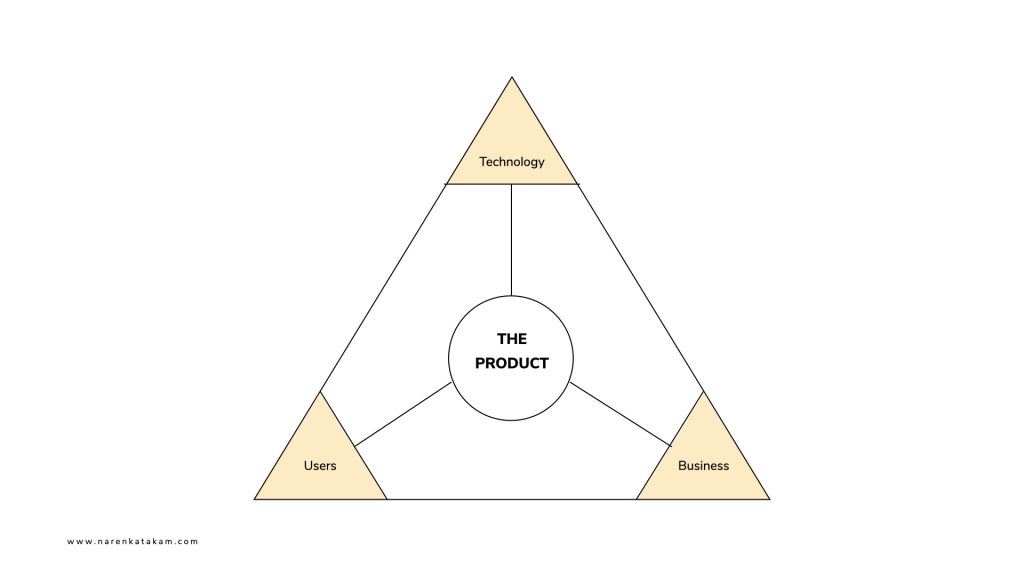
So, in that sense, a product can be defined as the result of the processes between users (what they need → problem space), business (what they can give → solution space) and the bridge that connects these two entities together, technology.

Then what is product thinking?
Product thinking is the journey from the problem space of the users to the solution space of the business. The goal of this journey is to reduce the gap between users and the business.
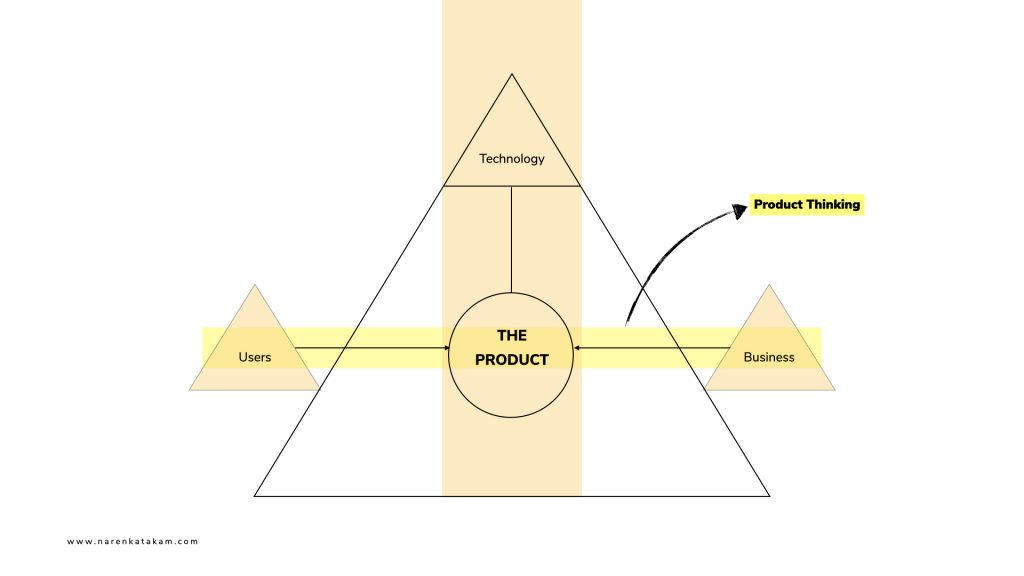
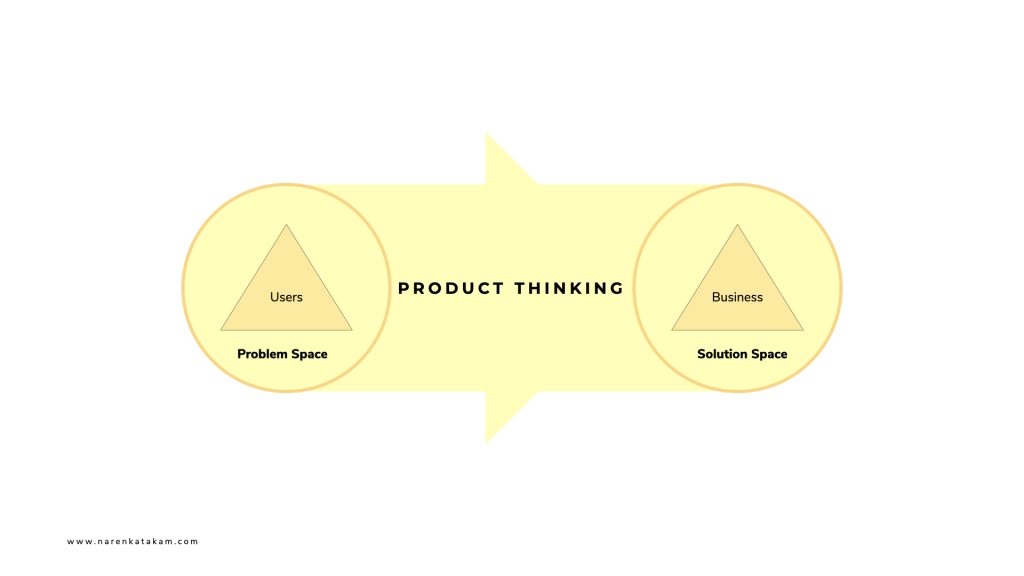
Why is product thinking important?
But first, why do products fail? In his 2007 blog post titled - "The only thing that matters", Marc Andreessen mentions that "the only thing that matters for a new startup is getting to a product-market fit". One of the main reasons why a product fails is because it fails to achieve product-market fit. It fails to meet customers (users) need in a way that is better than their current alternatives. In other words, → customers need X but the business decides to ship Y. The reason why businesses ship Y could be based on many reasons. Like, their lack of understanding of customer's needs clearly or their own business constraints on what they can offer at that point in time or lack of resources and team or hundred other reasons. No business wants to ship Y when customers need X but, it happens. A lot.
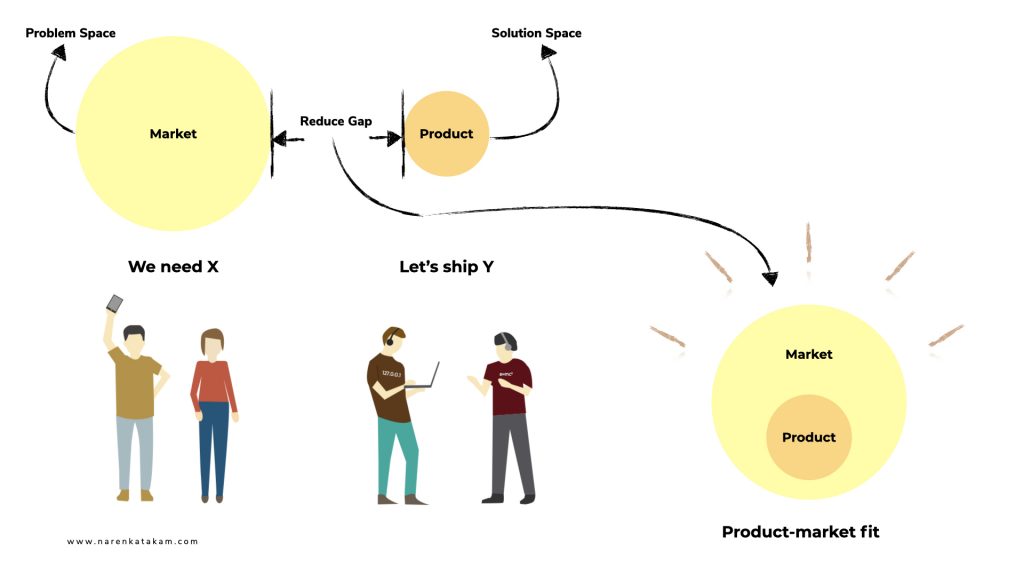
What can businesses do to avoid this pitfall? How can ‘product thinking’ help alleviate this situation? Keeping the ‘101’ aspect of this post in mind, let’s look at some basic heuristics of product thinking, more like thumb rules to follow to obscure failure.
Rule #1: Love the problem, not your solution.
Love the problem, not your solution → I first heard this mantra from Ash Maurya. His article with the same title elaborates more on how to avoid this pitfall by focusing on first principles. What this rule can do is help you in two ways, one, it eliminates innovator’s bias and two, it helps you embrace the problem space which in turn helps you understand your target market, users, customers, their needs and wants better.
Always, start with the problem. The answers to the questions like → what is the problem, who is facing this problem and why are they facing this problem will lead you to the market (a market: is a bunch of people having the same problem) and persona (a typical design persona from the sample size and not the marketing persona). When you apply 'jobs-to-be-done' (JTBD) to this persona from the sample size that's when you will truly begin to scratch the surface of the problem space (more on 'jobs-to-be-done' later in this post).
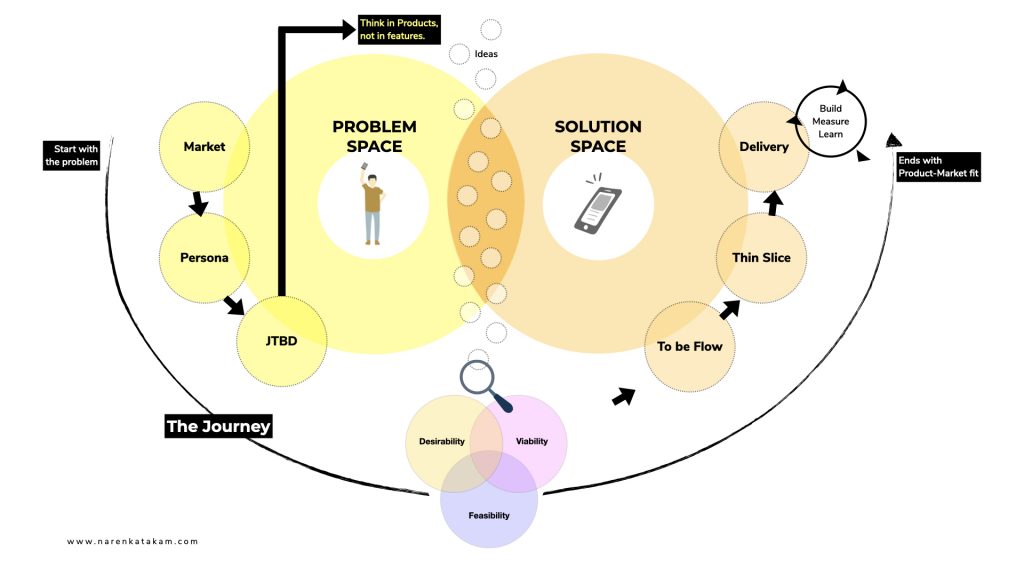
Rule #2: Think in products, not in features.
There’s an interesting article on “Why product thinking is the next big thing in UX design” by Nikkel Blasse. In this article, Nikkel talks about the importance of thinking in products and not in features.
I’d like to elaborate a bit on → What does thinking in products really mean? Thinking in products means zooming off from the micros and thinking in macros. Thinking about the problem and not getting lost in one of the possible solutions for that problem.
Thinking in product means understanding the problem thoroughly. And when you do that, that’s when you truly understand why you want to build the product, its purpose. This understanding makes you optimally select the features for your product, which avoid waste and in turn helps you become lean. Remember, successful products have repeatedly shown that users don’t care much about the features. Users only care about achieving their goals through your product. This is where Jobs-to-be-done (JTBD) fits so well to understand the job of a product/service in a user’s life.
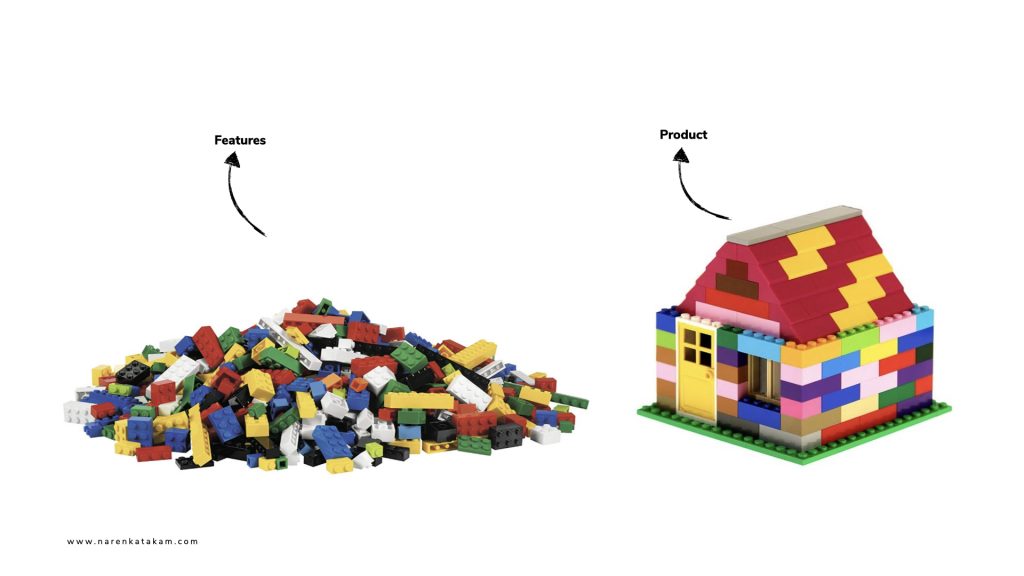
Rule #3: Have your product heuristics in place before writing your first line of code.
Building a software product is a continuous process. It’s a journey with many milestones. How can we lay certain ‘heuristics’ in place so that it helps us guide in our journey? Write down specific states to describe what the finished software will be and will do, more like placing strategic beacons in place that can throw light and define the silhouette of your finished product, a set of heuristics. This will help you immensely when the product is ready for launch, you can compare your creation with the pre-defined heuristics and you will know if the product is ready, or not. This action may be too simple on the outset, but I assure you it has profound effects when you launch and hear feedback from your customers.
There are two types of heuristics, one based on the desired physical ‘attributes’ of the final product, and two, desired ‘reactions’ one would like to expect from the end-users. For an effective product heuristics, use a blend of these two types. For example, take a look at the below heuristics from the image. 01 and 02 are the desired physical ‘attributes’ of a product whereas 03, 04 and 05 are the desired ‘reactions’ one would like to see from the end-users.

How can you cultivate product thinking?
One of the many things that stood out for me in Scott Adams' book "How to fail at almost everything and still win big" is the importance of "Systems" in our life. He defines → "a system is something you do on a regular basis that increases your odds of success (happiness) in the long run." In that sense, if you want to cultivate product thinking, you need a system around it. A system of tools and frameworks that can help you strengthen your core concepts. I have collated a few basic tools here (keeping it basic since it is 101) that can help you cultivate product thinking. I've picked three tools on the problem space and three for the solution space.
Problem Space Tool #1: Interrogative Pronouns - 5W1H (What, Who, Why, Where, When, & How)
5W1H is a basic questioning tool that can help you understand different facets of a problem. There's no particular order for Ws but remember, H generally comes last. For example, when you encounter a problem your line of questioning could be - What is the problem? who is involved? why does this problem exist? where does it occur? when did it begin? how could this problem be solved? and so on. You can get creative with the questioning especially with the hierarchy of W's based on the nature of the problem at hand.

An important aspect of these questions is when and how to to use them. If you want to think divergently or to expand your problem statement, then use why and what more frequently in your line of questioning. If you want to think convergently or to narrow down solution options then use how, who, when, where more frequently.

The other aspect that you have to be aware of is the 'bias' that could creep into the answers. How to eliminate or keep the bias out from the answers should be your goal? (this is where the next tool is super important and it makes sense to use both of them in conjuncture).
Problem Space Tool #2: Mom’s Test (Foolproof your questions)
I was researching on reducing bias in user data on an assignment last year and I came across this interesting concept from Rob Fitzpatrick called “Moms test”. The idea is very simple and exposes the relationship our minds have with the right words and the appeal it has on our mental models.
Mom’s test is all about a set of simple rules for crafting good questions that even your mom can’t lie to you about. For example, if you are interviewing a user about their fitness habits instead of asking “Do you go to a gym to keep yourself fit?” → this line of questioning can invite a lot of bias in the answer and the user can potentially lie based on his/her insecurities and guilt. According to Mom’s test, you should simply ask — “How many times did you go to the gym last week?” the chance of getting an honest unbiased answer goes up with this line of questioning.
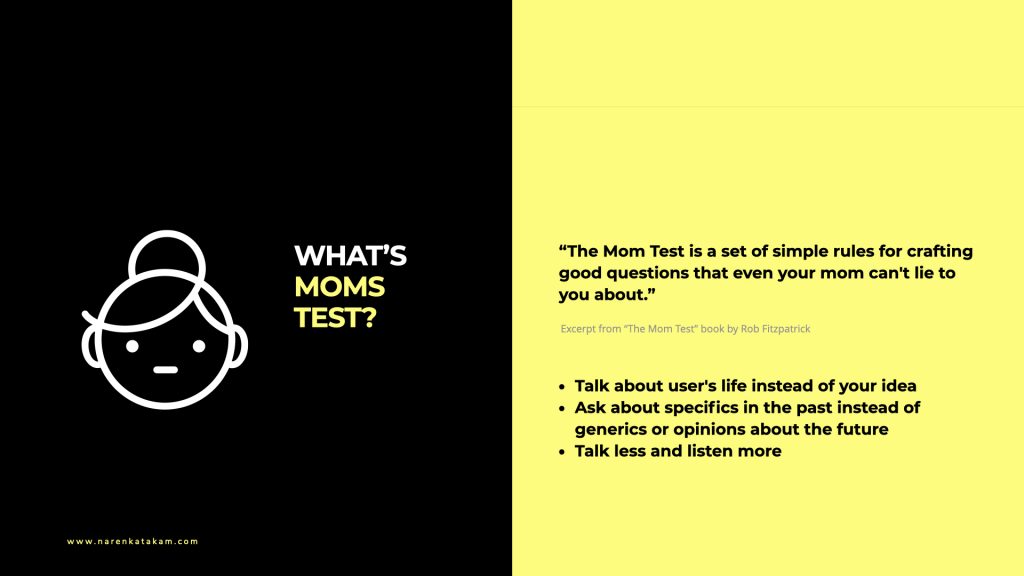
Problem Space Tool #3: Jobs-to-be-done (JTBD)
A couple of years ago, I came across this video of Clayton Christensen (he passed away recently in Jan 2020, God bless his soul!) talking about innovation, the importance of asking the right question and understanding the job of a product or a service in the life of a user. It was profound for me. It opened my mind in new ways.
Eventually this video became known as the milkshake video and I regularly refer to this video and the underlying concept behind it in my workshops on ‘the milkshake theory’ slide. Life came in full circle when some participants of my workshop immediately referred to this video when I mentioned the word ‘jobs-to-be-done’. It was very satisfying. I believe it was Anthony Ulwick who first theorized the concept of jobs-to-be-done in his seminal work on this subject — “What customers want” (published in the year 2005) which Clayton Christensen popularised it by connecting it to the macros of business innovation.
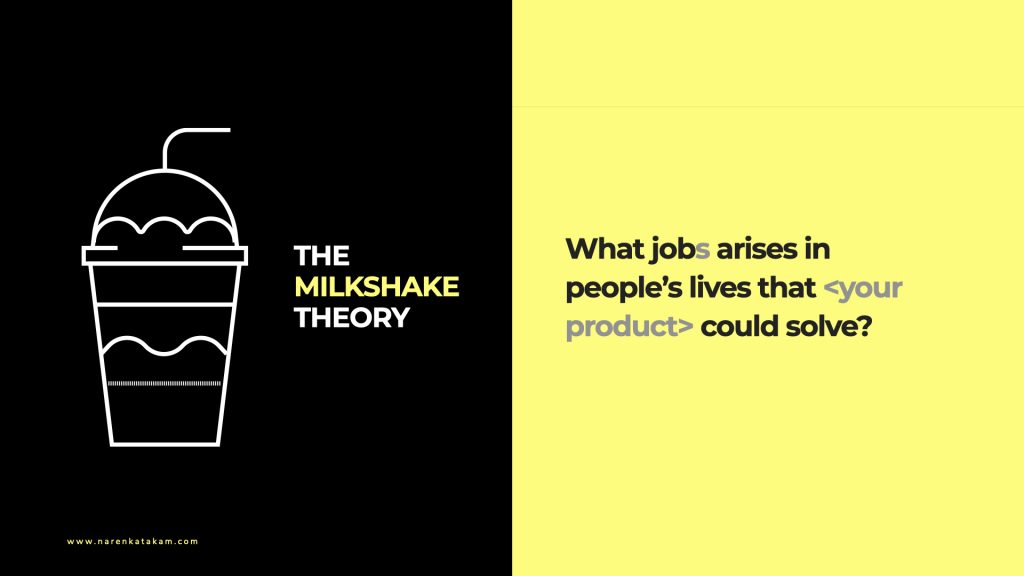
The idea is simple, when you try to understand the problem space, start with the question — “What job(s) arise(s) in people’s lives that your product could solve?” This question helps you get started on the current user journey, empathizing, understanding the problem, the current solutions, and the gaps.
Now that we have the tools to understand the problem space better which helps you spot the opportunity or gap in a system, let us get into the solution space and the tools.
Solution Space Tool #1: Get better at constructing hypothesis statement
A good hypothesis statement is the ultimate testimony of your problem space understanding. But first, what is a hypothesis? The best definition I found that seems to capture the essence of the word hypothesis is this → "A hypothesis is a testable explanation of an idea". In other words, any explanation that is not testable is not a valid hypothesis. As a product person, it pays off to understand the difference, the relationship and the hierarchy between an idea, hypothesis and assumptions. I've represented this in the figure below.
Ideas are abundant, but every idea cannot be a hypothesis. Only ideas that can be testable qualify as hypotheses. A single idea can have multiple hypothesis (hypotheses), Every hypothesis comes with a set of assumptions and as a product thinker or product manager it is your responsibility to test and validate these assumptions during product development. Ideas do have assumptions too but if an idea is not a hypothesis then these assumptions have no purpose in your path.
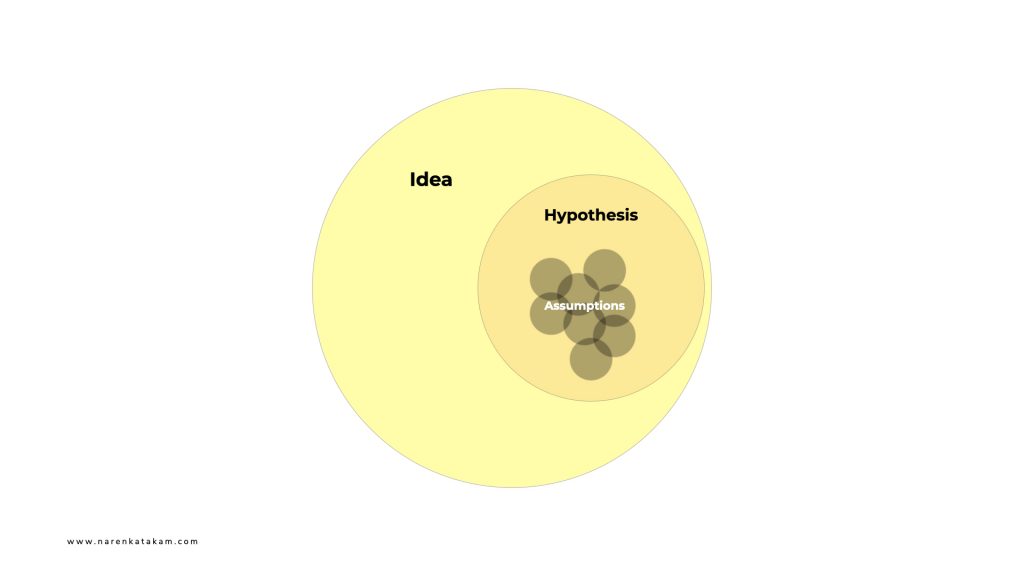
Solution Space Tool #1: Get better at constructing hypothesis statement
The shortest path to constructing a hypothesis statement to validate an idea and capture the testable aspect of the underlying assumptions is by using Josh Seiden and Jeff Golthelf's hypothesis template published in their book - "Lean UX". I've added annotations to expose the value of this template and the essential components it consists of, namely → A solution hypothesis, a market hypothesis, measurable outcome, and the signal to confirm the measured result. This is a great solution tool to have.
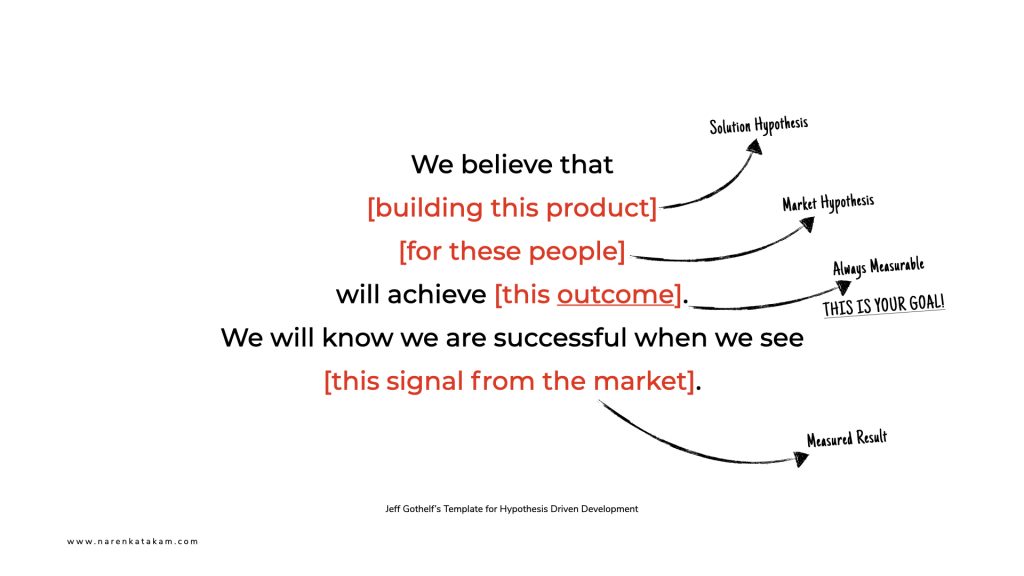
Solution Space Tool #2: Get creative with problem solving
When you get to solutioning, finding the right starting point could be pretty daunting at times. This is where you can get smart by standing on the shoulders of the giants. Look around for the proven models and systems. Below are six generic proven models that you could use as a starting point for solutioning.
- Transform: Transfer solution from one area to another. For example → We hear a lot of this is just like Uber but for pets, or for patients, or for something or someone else.
- Minimize: Reduce an existing solution. For example → When YouTube grew to a position where it was catering to a hub of various personas, Khan Academy was possible by focusing on just students and their need for simpler learning content.
- Maximize: Expand an existing solution. For example → Snapchat was the harbinger to introduce byte size personal videos, Instagram grew the same model with their mature influencer base, which in turn was taken to the next growth level by TikTok by democratizing influencer class altogether.
- Modify or Rearrange: Modify an existing solution. For example → Notion innovated from all the pain points from an Evernote user (there was no real innovation since inception) and modified the same product idea for better with a delightful experience.
- Substitute: Substitute a part of an existing solution. For example → E-book readers. Although the idea of an electronic book reading existed for a few decades it only materialized to become a huge market after the introduction of the iPhone. iPhone enabled users to read on their devices for longer periods this prepped the market for a separate e-book reader category and products like Kindle, Nook, Kobo were successful.
- Combine: Combine several existing solutions into one. For example: All super-apps like Alipay, Grab, Gojek fall into this category. Don’t use this model for first-release products, it defeats the idea of MVP and lean thinking. This model is good for advanced growth stages.
There are various creative ways to apply bullion operations on these models and find your bespoke approach to craft a solution.

Solution Space Tool #3: Start focusing on the outcome and not output
As a product thinker or product manager, you should start focusing on the outcome rather than output, the value you are generating versus estimation of development effort, and the accuracy of the product to do a job versus simplicity. Ok, the last point raised a few eyebrows during my presentation, especially among designers. If you have frowned too, then allow me to explain it a bit further.
Albert Einstein said — “It can scarcely be denied that the supreme goal of all theory is to make the irreducible basic elements as simple and as few as possible without having to surrender the adequate representation of a single datum of experience.” Very scientifically and eloquently put. However, what does it mean? Music composer Roger Sessions paraphrased the same quote into simpler English as this → “Everything should be made as simple as possible, but not simpler.” It’s simple and deep. Now, when I say accuracy over simplicity it is in this sense. I do not mean simplicity is not important but as a product manager, if you are ever caught in a trade-off between simplicity and accuracy, always prioritize accuracy. Do not ruthlessly focus on simplicity. For instance, do not ruthlessly focus on reducing the number of clicks to the shopping cart, focus on the goals behind the action of adding an item to the shopping cart.
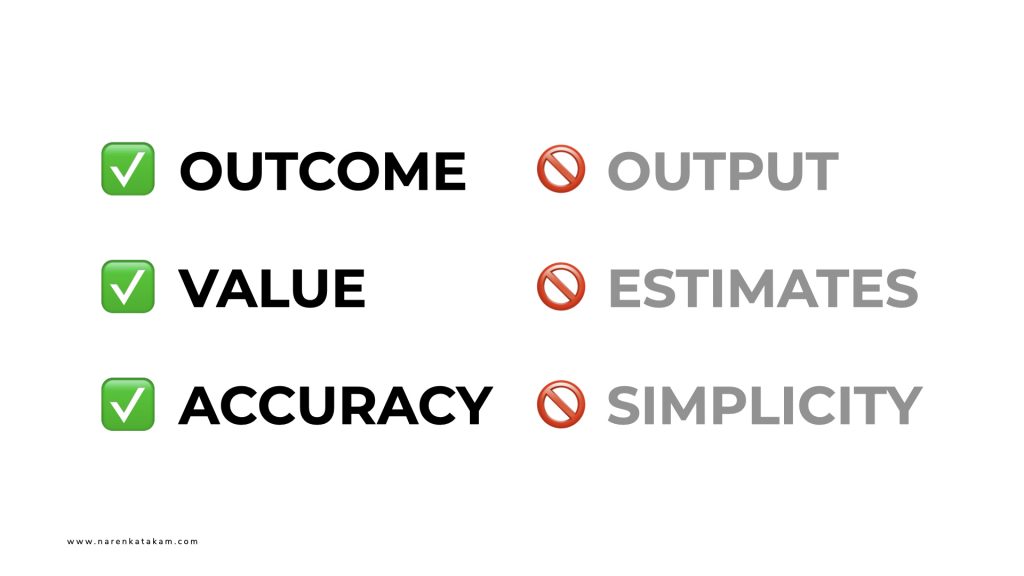
Key Takeaways
Here are the key takeaways from this post/presentation →
- Definition of product thinking
- Why is product thinking important and the 3 rules you have to keep in mind:
- Love the problem, not the solution
- Think in products, not in features
- Make products more meaningful with product thinking
- To cultivate product thinking try to apply these 3 problem space tools and 3 solution space tools on your next product idea:
- Problem space tool#1 → 5W1H
- Problem space tool#2 → MOMS TEST
- Problem space tool#3 → JTBD
- Solution space tool#1 → Hypothesis Template
- Solution space tool#2 → 6 Solution Models
- Solution space tool#3 → Outcome > Output
Webinar
I gave a webinar on 10 June 2020 Product Thinking 101, here's a recording of the webinar:
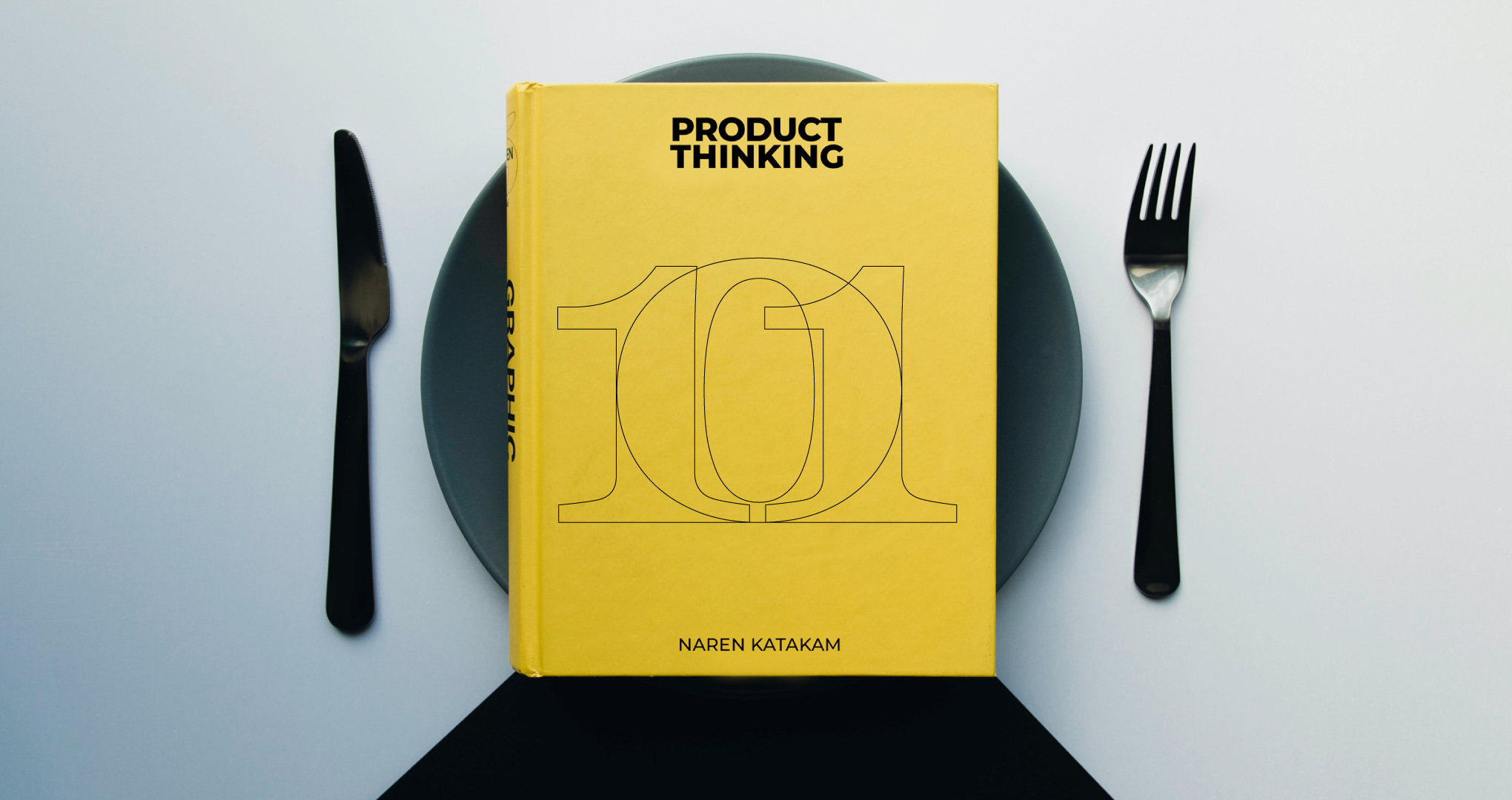
Thank you a lot for providing individuals with an exceptionally special chance to read in detail from here. It is always very pleasing and as well , packed with amusement for me and my office colleagues to visit your website the equivalent of three times in one week to find out the new tips you have. Of course, I am just certainly fascinated with your brilliant points you serve. Certain 3 ideas in this post are in reality the simplest we have ever had.
Das ist wirklich interessant. Sie sind ein sehr erfahrener Blogger. Ich bin Ihrem RSS-Feed beigetreten und freue mich darauf, mehr von Ihrem wunderbaren Beitrag zu erhalten. Außerdem habe ich Ihre Website in meinen sozialen Netzwerken geteilt! Chanda Pennie Malamud
Danke.
A good blog! I will bookmark a few of these.. Kelley Antonino Canada
I have to express my appreciation for your kind-heartedness in support of individuals who really need guidance on this particular topic. Your special commitment to getting the solution along ended up being certainly beneficial and has in most cases empowered folks much like me to get to their desired goals. Your personal warm and friendly tutorial entails much to me and much more to my office workers. Thank you; from everyone of us.
Olá eu amo o cabeçalho do seu blog, é uma criação pessoal? Gilli Gardner Minier
Sim
Thank you for all your valuable hard work on this site. My niece enjoys managing investigation and it’s really simple to grasp why. Most of us learn all about the compelling form you provide vital thoughts by means of your blog and as well foster participation from other ones about this subject matter plus my child is certainly starting to learn a whole lot. Enjoy the remaining portion of the year. You are doing a useful job.
I would like to express my love for your kind-heartedness giving support to persons who need help with this one area of interest. Your personal dedication to passing the solution all over had been extraordinarily interesting and have continually enabled men and women just like me to realize their targets. This valuable instruction signifies this much a person like me and a whole lot more to my peers. Thanks a lot; from everyone of us.
I have to point out my admiration for your kindness supporting those who absolutely need guidance on in this idea. Your personal commitment to passing the solution all-around turned out to be extraordinarily insightful and have surely enabled folks much like me to arrive at their aims. This insightful report implies much to me and somewhat more to my mates. Warm regards; from all of us.
I am just writing to let you be aware of what a perfect discovery my friend’s child developed browsing your blog. She even learned many issues, which include how it is like to possess an incredible giving character to let a number of people just thoroughly grasp chosen grueling subject matter. You undoubtedly did more than my desires. Many thanks for providing such practical, safe, revealing and also easy tips about your topic to Kate.
I would like to show thanks to you for bailing me out of this type of difficulty. After searching throughout the world wide web and coming across strategies which were not powerful, I assumed my life was over. Being alive without the presence of answers to the issues you have fixed through your good site is a critical case, and those that might have adversely damaged my entire career if I hadn’t come across the website. Your good knowledge and kindness in playing with the whole thing was valuable. I don’t know what I would have done if I hadn’t encountered such a stuff like this. I’m able to at this point relish my future. Thanks for your time so much for this expert and effective help. I will not be reluctant to suggest your blog to anyone who needs and wants guidelines on this issue.
Bonjour, ton blog est très réussi ! Je te dis bravo ! C’est du beau boulot !:) Danell Stillmann Montgomery
merci beaucoup.
I抎 have to verify with you here. Which is not something I normally do! I take pleasure in reading a put up that may make people think. Also, thanks for allowing me to remark!
Sie-haben einen fantastischen Blog Dank. Charis Mal Cima
Es hat sehr viel Spaß gemacht, Ihren Artikel zu lesen. Christabel Wade Kuhlman
Superbe blog, qui transpire la passion à l’état pur …